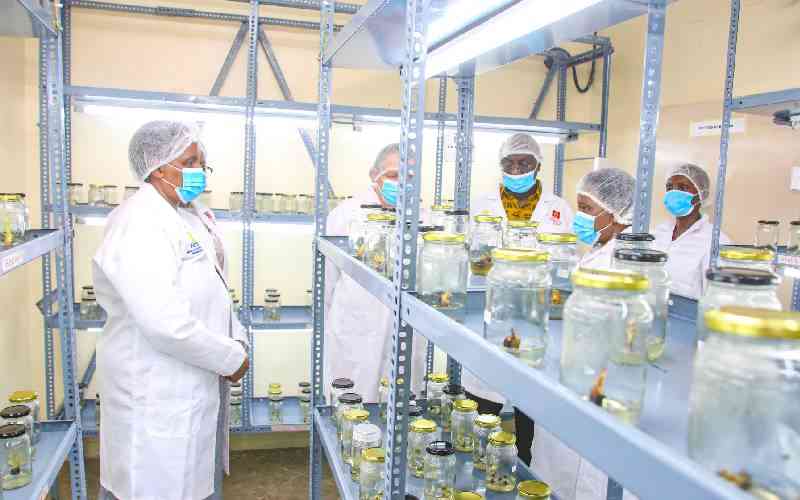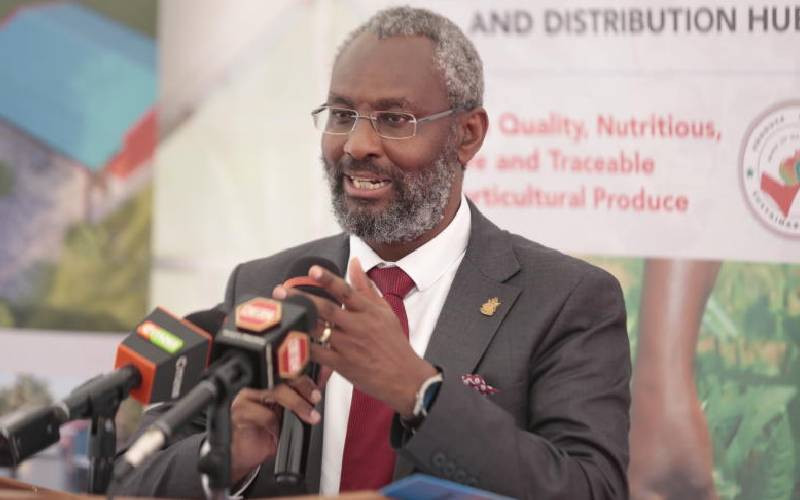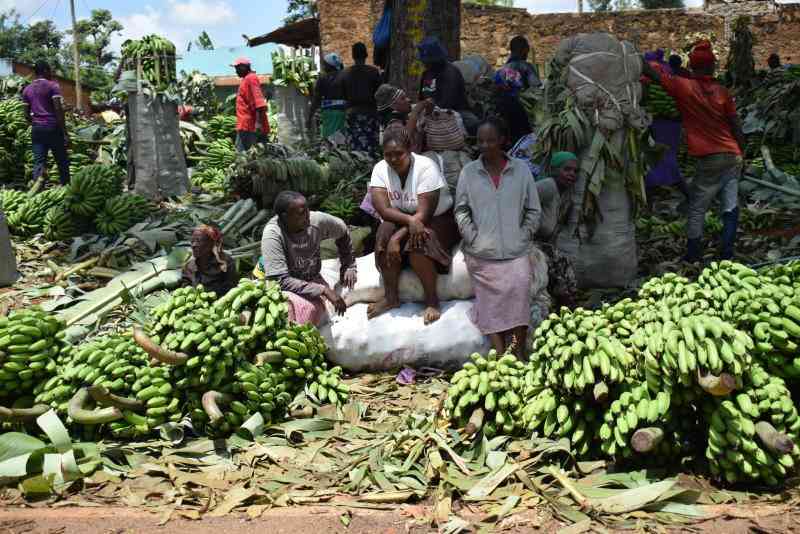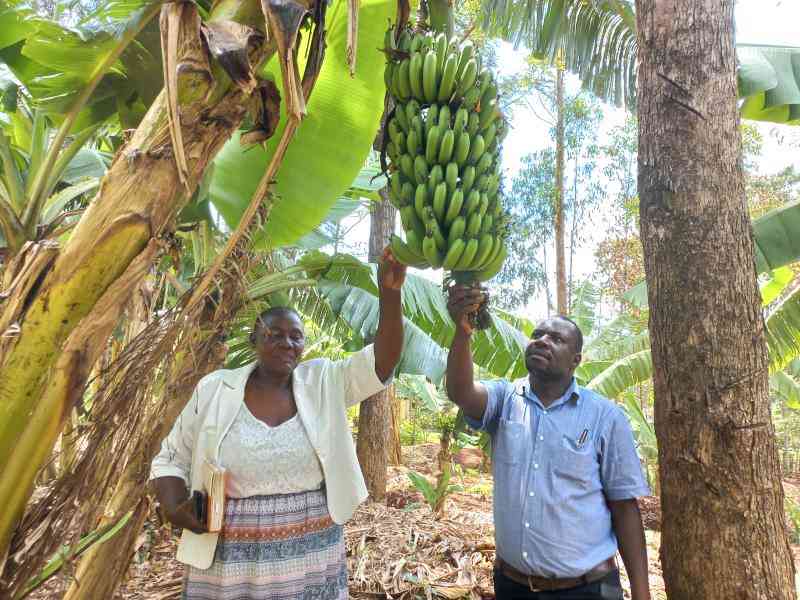Thanks to increasing demand and attractive market prices, banana farming is gaining momentum.
Until recently, use of conventional suckers as planting material has been the only option in banana farming. This method is preferred by many because it requires less inputs and the suckers can be planted immediately in the field.
However, the main predicament with this type of planting system is that the bananas are easily affected by pests and diseases such as Fusarium wilt, Sigatoka and Bacterial xanthomonas wilt (BXW).
Banana weevils and nematodes are also common in crops planted from suckers. Furthermore, virus such as banana streak and bunchy top disease are also spread through suckers.
Given these inadequacies, the traditional banana farming results in high mortality rates in the field. Should they establish, they take long to mature and the yield is normally low.
To address this problem, tissue-culture bananas have been introduced.
Tissue culture technique, well-known as micro-propagation, allows multiplication of uniform and high quality plant clones since they inherit the properties of the parent plant physically and genetically. Through this technique, more saplings are produced within a short time without the process of pollination. As a result healthy, virus-free and uniform seedlings are produced.
But most people mistake tissue-culture for genetically modified products.
Development of tissue-culture bananas
Tissue-culture plantlets are produced under sterile conditions in a laboratory for some weeks. The plantlets are then hardened in a greenhouse for six weeks. Notably, tissue culture speeds up the multiplication process significantly and up to 2,000 healthy bananas can be produced from a single shoot through this method.
Conventional bananas, on the other hand, produce 10 suckers in six months. Similarly, tissue-culture bananas produce fruits in 340 days as compared to 420 days for ordinary bananas. The average hectar yield for tissue-culture bananas is 30-40 tonnes, twice the yield for traditional breeds.
Uniform growth and almost synchronised maturity will facilitate proper management of harvests, improve quality of the product and help estimate a better output value. Production and marketing of tissue-culture bananas are therefore more efficient.
To reap full benefits from the tissue-culture technique, a farmer must have large quantities of clean and superior planting material, promote good farm hygiene practices through proper management of the crop. This will substantially decrease the yield losses due to pests and diseases.
Additional advantages accruing from the superiority of the planting material are its early fruiting and maturing period, bigger bunch weights and a higher annual yield per unit of land.
Conventional planting materials carry pests and diseases from the mother plant. But there are means to reduce pest load before planting. Tissue-culture plantlets, on the other hand, are free from pests, fungal and most bacterial pathogens. If they have been properly indexed, they should also be free of viruses. However, they are easily infected with pests and diseases if transplanted in infested soils.
Stay informed. Subscribe to our newsletter
Tissue-culture plantlets are more expensive than conventional planting materials and may not be readily available, as many counties do not have the facilities to produce them. Moreover, the number of cultivars sold by the laboratories is generally limited.
Tissue-culture plantlets also require appropriate management practices right after being transplanted to the field.
Growing tissue culture bananas
The farm has to have the right conditions for the growth of bananas, which do well from an altitude of 1,800 metres above sea level and a minimum rainfall of 1,000m per year, which is particularly critical during flowering. Farmers in low rainfall areas should ensure that irrigation is done throughout. Soils should be fertile and well drained to avoid water logging.
Farmers can get these plantlets from licensed nurseries (examples are the Jomo Kenyatta University of Agriculture and Technology and the Kenya Agricultural and Livestock Research Organisation). Half a month before planting, pits measuring three feet by three feet by three feet should be prepared. Subsoil and topsoil should be separated and well rotten manure mixed with the topsoil, fertiliser and the recommended nematicide.
The banana hole should be filled with the mixture, and the plantlets planted 30cm deep in the hole. The soil should then be firmed.
Dry mulches should be used to retain moisture while heavy banana stems should be supported to avoid damage. Old diseased leaves should be removed because de-leafing ensures healthy growth. Harvesting begins after 15-18 months, and a light shiny appearance means that the banana is ready for harvest. Harvesting should be delicate to avoid bruising of the bananas.
The fruit should be temporarily stored in a cool, dry place wrapped in banana leaves or grass to avoid bruising. If for export, they should be washed using a disinfectant and branded.
It is apparent that tissue-culture bananas have many advantages over conventional suckers. However, there are hurdles that limit widespread uptake and optimal use of tissue-culture technology among smallholder farmers.
Distribution systems of tissue-culture plantlets to farmers is one key obstacle. Plantlets are often distributed in large quantities at subsidised prices by various development partners, but this is not sustainable in the long run. Tissue culture plantlets are fragile, and their thriving depends on good management by nursery operators and farmers, especially in the early stages.
To sum it up, Kenya’s relatively stable economy and all year round growing season holds great potential for the local and export markets. Tissue-culture bananas can help increase production of this popular fruit. Only four per cent of banana exports originate from Africa while one-third of the plantlets is grown in the continent. This disparity could be an excellent opportunity for farmers to supply their fruits to bigger markets.
 The Standard Group Plc is a
multi-media organization with investments in media platforms spanning newspaper
print operations, television, radio broadcasting, digital and online services. The
Standard Group is recognized as a leading multi-media house in Kenya with a key
influence in matters of national and international interest.
The Standard Group Plc is a
multi-media organization with investments in media platforms spanning newspaper
print operations, television, radio broadcasting, digital and online services. The
Standard Group is recognized as a leading multi-media house in Kenya with a key
influence in matters of national and international interest.
 The Standard Group Plc is a
multi-media organization with investments in media platforms spanning newspaper
print operations, television, radio broadcasting, digital and online services. The
Standard Group is recognized as a leading multi-media house in Kenya with a key
influence in matters of national and international interest.
The Standard Group Plc is a
multi-media organization with investments in media platforms spanning newspaper
print operations, television, radio broadcasting, digital and online services. The
Standard Group is recognized as a leading multi-media house in Kenya with a key
influence in matters of national and international interest.









